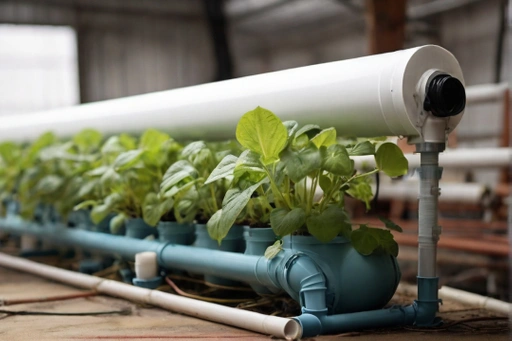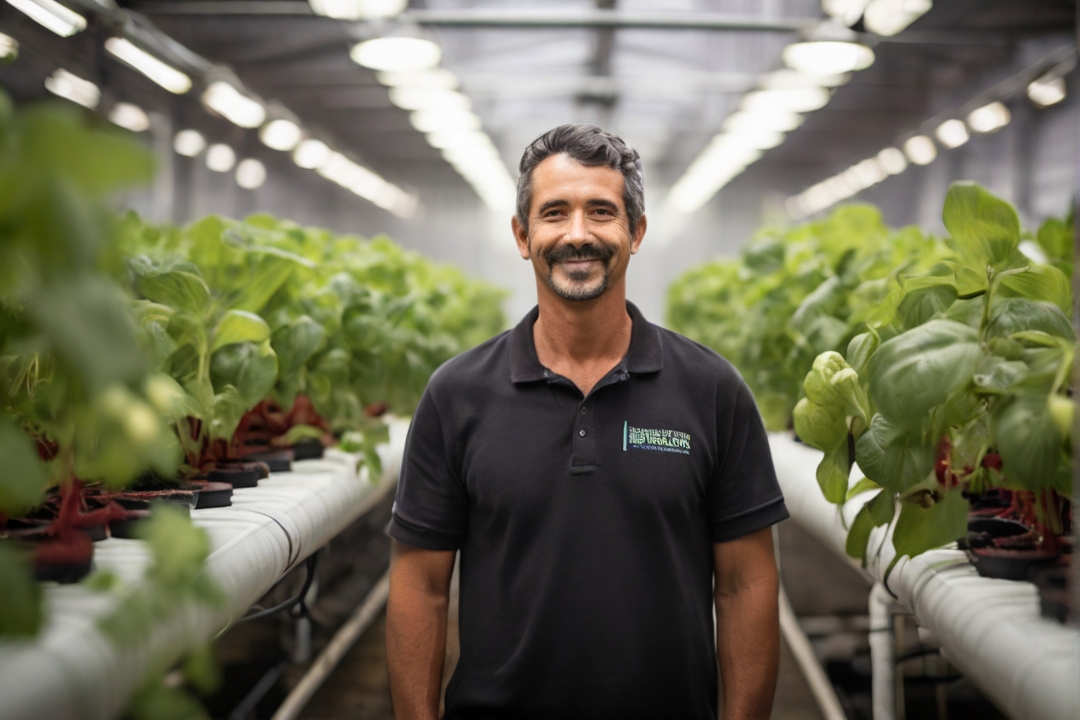Unlike traditional soil-based fertilizers, hydroponic fertilizer is designed to be dissolved in water and delivered directly to the plant’s roots. This allows control over nutrient levels and ensures that plants receive the precise amount of nutrients they need.
One of the main benefits of using hydroponic fertilizer is that it allows plants to absorb nutrients faster and more efficiently. Since the nutrients are dissolved in water, they are readily available for absorption by the plant’s roots. Plants can thus take up nutrients more quickly and efficiently, leading to faster growth and higher yields.
Table of Contents
- Understanding the Nutrient Requirements of Plants in Hydroponic Systems
- Types of Hydroponic Fertilizers: Liquid vs. Powdered Formulations
- Essential Nutrients for Plant Growth: Macronutrients and Micronutrients
- Choosing the Right Hydroponic Fertilizer for Your Plants
- Factors to Consider When Selecting a Hydroponic Fertilizer: pH, EC, and PPM
- How to Mix and Apply Hydroponic Fertilizer Solutions for Optimal Plant Growth
- Common Hydroponic Fertilizer Mistakes to Avoid: Overfeeding and Underfeeding
- Troubleshooting Nutrient Deficiencies in Hydroponic Systems
- Hydroponic Fertilizer Maintenance and Storage: Tips for Long-Term Use
- Conclusion
- FAQs
Understanding the Nutrient Requirements of Plants in Hydroponic Systems
Plants require various nutrients, including macronutrients and micronutrients, to grow and thrive. Macronutrients, including nitrogen, phosphorus, potassium, calcium, magnesium, and sulfur, are needed in larger quantities. Micronutrients are required in smaller quantities but are equally crucial for plant growth and include iron, manganese, zinc, copper, boron, molybdenum, and chlorine.
Due to the absence of soil, the nutrient requirements of plants in hydroponic systems can differ from those in soil-based systems. In soil-based systems, plants can extract nutrients from the soil as needed. However, all nutrients must be provided through the nutrient solution in hydroponic systems.
Maintaining the proper nutrient balance in hydroponic systems is crucial for plant health and growth. Imbalances or nutrient deficiencies can lead to stunted growth, nutrient deficiencies, or even plant death. It is essential to regularly monitor nutrient levels and adjust the solution accordingly to ensure that plants are receiving all the necessary nutrients.
Types of Hydroponic Fertilizers: Liquid vs. Powdered Formulations
Hydroponic fertilizers are available in both liquid and powdered formulations. Liquid fertilizers are pre-mixed solutions that can be easily added to the nutrient reservoir. They are convenient and provide a quick and easy way to deliver nutrients to plants.
On the other hand, powdered fertilizers are concentrated and need to be mixed with water before use. They offer more flexibility regarding nutrient ratios. They can be customized to meet the specific needs of different plants.
Both liquid and powdered hydroponic fertilizers have their advantages and disadvantages. Liquid fertilizers are easier to use and require no mixing, but they can be more expensive than powdered formulations. Powdered fertilizers, on the other hand, are more cost-effective but require more time and effort to mix correctly.
When choosing between liquid and powdered hydroponic fertilizers, consider cost, ease of use, and your plants’ specific needs. Some growers prefer the convenience of liquid fertilizers, while others prefer the flexibility of powdered formulations.
Essential Nutrients for Plant Growth: Macronutrients and Micronutrients

Plants need a range of essential nutrients for optimal growth and development. These nutrients can generally be divided into two categories: macronutrients and micronutrients.
Macronutrients are needed in larger quantities and play a crucial role in plant growth. The primary macronutrients include nitrogen (N), phosphorus (P), and potassium (K), also known as NPK. Nitrogen is essential for leaf and stem growth, phosphorus is important for root development and flowering, and potassium is necessary for overall plant health and disease resistance.
In addition to the primary macronutrients, plants also require secondary macronutrients such as calcium (Ca), magnesium (Mg), and sulfur (S). Calcium is essential for cell wall development, magnesium is needed for chlorophyll production, and sulfur is necessary for protein synthesis.
Micronutrients are needed in smaller quantities but are equally crucial for plant growth. These include iron (Fe), manganese (Mn), zinc (Zn), copper (Cu), boron (B), molybdenum (Mo), and chlorine (Cl). Micronutrients are involved in various metabolic processes and are crucial in enzyme activation, photosynthesis, and overall plant health.
Providing plants with all the necessary macronutrients and micronutrients is essential for optimal growth and development. A balanced nutrient solution that contains the correct ratios of macronutrients and micronutrients will ensure that plants have everything they need to thrive.
Choosing the Right Hydroponic Fertilizer for Your Plants

When choosing a hydroponic fertilizer, several factors must be considered. First, you need to determine the specific nutrient requirements of your plants. Different plants have different nutrient needs, therefore choosing a fertilizer that has the right balance of nutrients for your specific crops is essential.
Next, consider the type of hydroponic system you are using. Some systems, such as deep water culture or nutrient film technique, may require a different type of fertilizer. It is essential to choose a fertilizer that is compatible with your chosen system.
It would help if you also considered the growth stage of your plants. Young seedlings have different nutrient requirements than mature plants, so it is essential to choose a fertilizer appropriate for the growth stage your plants are in.
Finally, consider your budget and the availability of the fertilizer. Some fertilizers can be expensive, so choosing one that fits your budget is essential. Additionally, some fertilizers may not be readily available, so choosing one you can easily access is essential.
Factors to Consider When Selecting a Hydroponic Fertilizer: pH, EC, and PPM
When selecting a hydroponic fertilizer, it is essential to consider factors such as pH, electrical conductivity (EC), and parts per million (PPM). These factors play a crucial role in nutrient uptake and plant health.
A solution’s pH measures its acidity or alkalinity. Different plants have different pH preferences, so choosing a fertilizer within the optimal range for your plants is essential. Most hydroponic crops prefer a slightly acidic pH between 5.5 and 6.5.
EC measures the concentration of salts in a solution. It indicates nutrient strength and can help determine whether plants receive the proper nutrients. The ideal EC level will vary depending on the crop and growth stage. Still, it generally falls between 1.2 and 2.0 mS/cm.
PPM is a measure of the concentration of dissolved solids in a solution. It is another way to measure nutrient strength and can be used to ensure that plants are receiving the right amount of nutrients. The ideal PPM level will vary depending on the crop and growth stage but generally between 800 and 1500 PPM.
Monitoring pH, EC, and PPM levels is crucial for maintaining optimal nutrient levels in hydroponic systems. Adjusting these levels as required will ensure that plants receive all nutrients for healthy growth.
How to Mix and Apply Hydroponic Fertilizer Solutions for Optimal Plant Growth
Mixing and applying hydroponic fertilizer solutions correctly is essential for optimal plant growth. Here is a step-by-step guide to help you get started:
1. Start by filling your nutrient reservoir with water. Use clean, filtered water if possible.
2. Measure the appropriate amount of hydroponic fertilizer according to the manufacturer’s instructions. Follow the recommended dosage rates to avoid overfeeding or underfeeding your plants.
3. Add the fertilizer to the water in the nutrient reservoir. Stir or agitate the solution to ensure that the fertilizer is fully dissolved.
4. Measure the nutrient solution’s pH, EC, and PPM levels using a pH meter, EC meter, and PPM meter. Adjust these levels as needed using pH up or down solutions and additional nutrients.
5. Once the nutrient solution is mixed correctly and adjusted, it can be applied to your hydroponic system. Follow the manufacturer’s instructions for your system to determine how to deliver the nutrient solution to your plants.
It is important to note that different crops and growth stages may require different nutrient concentrations and application rates. Monitoring your plants closely and adjusting to ensure they receive all the nutrients for optimal growth is essential.
Common Hydroponic Fertilizer Mistakes to Avoid: Overfeeding and Underfeeding
One of the most common mistakes that growers make when using hydroponic fertilizers is overfeeding or underfeeding their plants. Both of these mistakes can have severe consequences for plant health and growth.
Overfeeding occurs when plants receive too many nutrients, leading to nutrient imbalances or toxicities. This can result in stunted growth, leaf burn, or even plant death. It is essential to follow the manufacturer’s instructions for dosage rates and avoid adding more fertilizer than recommended.
Underfeeding, on the other hand, occurs when plants do not receive enough nutrients. This can result in nutrient deficiencies, stunted growth, and poor yields. To ensure that plants receive all the necessary nutrients, it is essential to regularly monitor nutrient levels and adjust the nutrient solution as needed.
To avoid overfeeding and underfeeding, it is essential to closely monitor your plants and make adjustments as needed. Regularly check pH, EC, and PPM levels and adjust them accordingly. Additionally, pay attention to your plants’ growth and appearance. If you notice any signs of nutrient deficiencies or toxicities, take action immediately to correct the issue.
Troubleshooting Nutrient Deficiencies in Hydroponic Systems
Nutrient deficiencies can occur in hydroponic systems if plants are not receiving all the necessary nutrients. Common nutrient deficiencies include nitrogen, phosphorus, potassium, iron, and magnesium deficiencies.
It is essential to closely monitor plants’ growth and appearance to identify nutrient deficiencies. Common signs of nutrient deficiencies include yellowing or browning of leaves, stunted growth, poor flowering or fruiting, and leaf curling or distortion.
If you suspect a nutrient deficiency, you should take action immediately to correct the issue. This may involve adjusting the nutrient solution by adding more of the deficient nutrient or adjusting the pH, EC, or PPM levels. Ensuring all other nutrients are in the correct ratios is also essential.
If you are unsure how to correct a nutrient deficiency or if the issue persists despite your efforts, it may be helpful to consult a hydroponic expert or horticulturist for guidance.
Hydroponic Fertilizer Maintenance and Storage: Tips for Long-Term Use
Proper maintenance and storage of hydroponic fertilizers are essential for long-term use and effectiveness. Here are some tips to help you maintain the potency of your fertilizers:
1. Store fertilizers in a cool, dry place away from direct sunlight. Exposure to heat and light can degrade the quality and effectiveness of the fertilizer.
2. Keep fertilizers tightly sealed to prevent moisture from entering. Moisture can cause powdered fertilizers to clump or cake and spoil liquid fertilizers.
3. Check the expiration date on the fertilizer packaging. Using expired fertilizers can result in poor plant growth and nutrient imbalances.
4. Do not prepare large batches of nutrient solution in advance. Mixing small batches as needed to ensure freshness and potency is best.
5. Clean and sanitize your nutrient reservoir regularly to prevent the buildup of algae, bacteria, or other contaminants that can affect the quality of the nutrient solution.
6. Properly dispose of unused or expired fertilizers. Follow local regulations for the disposal of chemical products and avoid pouring them down drains or into water sources.
Following these tips can help your hydroponic fertilizers remain potent and effective for long-term use, resulting in healthy plants and high yields.
Conclusion
In conclusion, hydroponic fertilizer offers numerous benefits and advantages over traditional soil-based fertilizers. It allows for faster and more efficient nutrient uptake by plants, eliminates the risk of pests and diseases associated with soil, and provides precise control over nutrient levels. Understanding the nutrient requirements of plants in hydroponic systems is crucial for maintaining proper nutrient balance and ensuring optimal plant growth.
Choosing the right hydroponic fertilizer involves considering nutrient requirements, hydroponic system type, growth stage, budget, and availability. Monitoring pH, EC, and PPM levels is essential for maintaining optimal nutrient levels in hydroponic systems. Mixing and applying hydroponic fertilizer solutions correctly is essential for plant health and growth. Avoiding common mistakes such as overfeeding or underfeeding plants is crucial, as is troubleshooting nutrient deficiencies promptly. Proper maintenance and storage of hydroponic fertilizers will ensure their long-term effectiveness. By following these guidelines, growers can achieve healthy plants and high yields in their hydroponic systems.
FAQs
What grows the fastest in hydroponics?
Leafy greens like lettuce, spinach, and kale often grow the fastest in hydroponic systems due to their low nutrient requirements and quick harvest times.
What is the ratio of fertilizer to water in hydroponics?
The ratio of fertilizer to water in hydroponics varies depending on the plants and the specific nutrients used. Generally, nutrient solutions are mixed at a rate of 1-2 teaspoons of fertilizer per gallon of water, but it’s essential to follow specific nutrient mix instructions or consult a hydroponic nutrient calculator.
How long does hydroponic fertilizer last?
Hydroponic fertilizers can last for several years when stored properly in a cool, dry place. However, once mixed with water, the nutrient solution should be used within a week or two to ensure its effectiveness.
What is the difference between hydroponic fertilizer and regular fertilizer?
Hydroponic fertilizers are water-soluble and provide a balanced nutrient profile tailored for plants growing in a soilless environment. Regular fertilizers are often designed for soil use and may not dissolve completely in water, making them less suitable for hydroponic systems.
How often do you change hydroponic water?
The water in hydroponic systems should be changed every two to three weeks. This helps prevent nutrient imbalances and the buildup of salts and other harmful substances. However, the frequency can vary depending on the size of the system, the type of plants, and the specific setup.
- Read a study focusing on the potential benefits of recycling drainage water in low-cost hydroponic greenhouses here.

